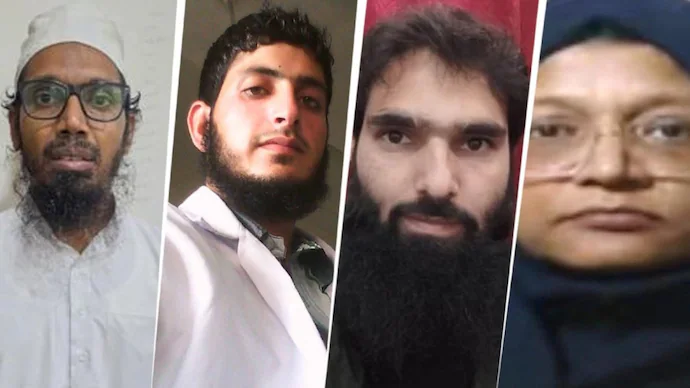India Terror Module Bust: In a major counter-terror breakthrough, India has once again demonstrated its unwavering resolve to combat terrorism. A massive Jaish-e-Mohammed (JeM) module, linked to the recent Red Fort blast, has been dismantled through coordinated efforts by Indian intelligence and law enforcement agencies.
The operation—spanning Delhi, Haryana, and Jammu & Kashmir—has uncovered nearly 3,000 kilograms of explosives, preventing what could have been one of the deadliest terror attacks in recent years.
This is not just a story of arrests and seizures — it’s a story of vigilance, precision, and India’s unflinching commitment to protect its citizens from terror.
Table of Contents
The Beginning: A Blast That Unfolded a Larger Plot
On the evening of November 10, 2025, an explosion shook the area near Delhi’s Red Fort Metro Station. Panic spread instantly, but within hours, India’s security agencies had swung into action.
Preliminary investigations revealed that the car used in the explosion was linked to a larger terror network operating out of Faridabad, Haryana, with deep ties to the banned outfit Jaish-e-Mohammed.
What seemed like an isolated blast soon turned into a trail that led India’s investigators to a web of terror, deceit, and indoctrination—stretching from Srinagar to Saharanpur.
Tracing the Trail: From Srinagar Posters to Faridabad Explosives
The chain of events began on October 19, 2025, when objectionable posters were found near the Naugam Police Post in Srinagar. A First Information Report (FIR) was promptly registered, which led to the arrest of Maulvi Irfan Ahmad Waghe from Shopian and Zameer Ahmad from Wakura, Ganderbal between October 20–27.
Subsequent investigations led to a breakthrough on November 5, when Dr. Adeel was apprehended from Saharanpur. His links to a radicalized medical network soon emerged.
Within days, on November 7, AK-56 rifles, ammunition, and detonators were recovered from Anantnag Hospital, followed by another seizure on November 8 at Al-Falah Medical College, Faridabad.
The turning point came when Dr. Muzammil, also from Al-Falah Medical College, was arrested—his interrogation revealed the existence of a full-fledged JeM module, operating under the guise of medical professionals.
The Explosive Find: 3,000 Kg of Bomb-Making Material
On November 10, intelligence units zeroed in on Dhauj and Dheerha Colony in Faridabad, where massive raids were conducted.
What followed shocked even seasoned officers:
- 2,563 kg of explosive materials were seized from the house of Hafeez Mohammad Ishtiaq, an Imam at Al-Falah Mosque and resident of Mewat.
- Another 358 kg of explosive components, detonators, and timers were recovered during follow-up searches.
In total, nearly 3,000 kilograms of explosives and bomb-making materials were seized—evidence of a large-scale conspiracy to carry out multiple blasts across India.
One key suspect, Dr. Umar, believed to have driven the car that exploded near the Red Fort, remains on the run. According to CCTV footage and forensic traces, Umar was part of the same JeM-linked medical module.
Investigators believe that either the Red Fort blast was pre-planned, or an accidental detonation occurred as the module scrambled under mounting pressure from security agencies.
Swift Government Response: A Case Handed Over to NIA
Immediately after the Red Fort explosion, Union Home Minister Amit Shah personally reviewed the situation.
Timeline of Key Actions:
- 6:55 PM, Nov 10: Blast reported near Red Fort Metro Station.
- 7:15 PM: Home Minister speaks with Delhi Commissioner for details.
- 9:00 PM: Minister briefs media; Prime Minister Narendra Modi is updated.
- 9:30–10:20 PM: Amit Shah visits LNJP Hospital, meets victims, doctors, and officers; later inspects the blast site.
- Nov 11, 11:00 AM: Two back-to-back high-level meetings with IB, NIA, NSG, and Delhi Police officials.
- 2:30 PM: The case officially handed over to the National Investigation Agency (NIA) for a comprehensive probe into the terror module’s financing and coordination.
The Ministry of Home Affairs confirmed that forensic teams had already collected DNA samples, residue from explosives, and material evidence from the blast site for analysis.
India’s Counter-Terror Machinery in Action
The successful dismantling of this Jaish-e-Mohammed network reflects the coordination and precision of India’s intelligence ecosystem.
From tracing online communications to tracking financial routes, and from identifying fake medical fronts to nabbing key operatives across states — the operation highlights how deeply rooted and synchronized India’s counter-terror infrastructure has become.
Security experts note that terror outfits have begun using civilian fronts, like educational or healthcare institutions, to evade suspicion. But India’s intelligence agencies, armed with advanced digital surveillance and human intelligence, are now more adept than ever at uncovering these layers.
Why This Matters Globally
This operation sends a powerful message—not only to terror outfits but to nations supporting them from the shadows: India will respond swiftly, decisively, and within the framework of law.
The Red Fort holds immense symbolic value, representing India’s sovereignty and independence. Any attempt to target it is seen as an assault on the nation’s pride — and India’s robust response ensures that such acts do not go unanswered.
Moreover, India’s approach showcases a 21st-century counter-terror strategy — intelligence-led, technology-driven, and globally coordinated.
ByNews-View: Precision, Not Noise – India’s Real Message to Terror
India’s crackdown on the Red Fort terror module is not just another police operation; it’s a reaffirmation of the country’s iron resolve. While the arrests and seizures demonstrate remarkable efficiency, it also calls for constant vigilance — because terrorism today is adaptive, deceptive, and often disguised in unexpected forms.
What stands out is India’s balance between strength and restraint. The swift action, the evidence-based investigation, and the coordination across agencies prove that national security doesn’t need noise — it needs precision.
The world is watching – and India just showed how a democracy can fight terror with both courage and credibility.
Also read:

